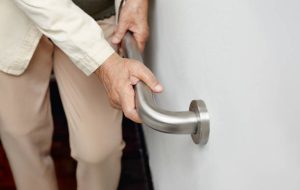The two main reasons for hospital admissions for the over 75 age group, are falls and medication mismanagement.
In Canada, falls account for over 6,500 death each year. Many of these deaths and hospitalizations are preventable.
As we age, our homes should evolve to meet our changing needs. Making thoughtful modifications can help maintain independence while reducing the risk of accidents and injuries. Here are essential safety considerations for key areas of your home.
Bathroom Safety: The Priority Zone
The bathroom presents the highest risk for falls and injuries among older adults due to wet surfaces and frequent transfers between sitting and standing positions. Start with installing grab bars near the toilet, inside the shower or tub, and along walls where support is needed. These should be professionally installed into wall studs to support at least 250 pounds.
Consider adding a shower seat or bench to reduce fatigue and fall risk while bathing. Non-slip mats both inside the tub and on the bathroom floor provide crucial traction. Raised toilet seats can make sitting and standing easier, while a handheld showerhead offers better control and reduces the need to move around in slippery conditions.
Good lighting in the bathroom is essential, especially for nighttime visits. Motion-activated night lights can illuminate the path from bedroom to bathroom without requiring fumbling for switches in the dark.
Illuminating Safety: Proper Lighting Throughout the Home
Adequate lighting becomes increasingly important as vision changes with age. Each room should have multiple light sources to eliminate shadows and dark corners. Table lamps, floor lamps, and overhead fixtures should work together to create even illumination.
Hallways and stairways require particular attention. Install light switches at both ends of hallways and at the top and bottom of stairs. Consider motion-sensor lights for automatic illumination during nighttime navigation. LED bulbs provide bright, energy-efficient lighting and last longer, reducing the need for frequent bulb changes.
Eliminate glare by using lampshades and positioning lights to avoid reflection off surfaces like television screens or glossy tables. Under-cabinet lighting in the kitchen improves visibility for food preparation and cooking tasks.
Stair Safety: Secure Handrails and More
Stairs present significant hazards, making proper handrails absolutely essential. Install sturdy handrails on both sides of stairways, extending them beyond the top and bottom steps for additional support during mounting and dismounting. Handrails should be 34 to 38 inches high and provide a comfortable grip.
Ensure all steps are in good repair with no loose boards or torn carpeting. Each step should be clearly visible, which may require painting the edge of each step with contrasting paint or adding non-slip strips. Keep stairs free of clutter, and never store items on steps, even temporarily.
If mobility becomes significantly limited, consider installing a stair lift or, if possible, relocating sleeping quarters to the main floor to eliminate daily stair use.
Rug Management: Comfort Versus Safety
While area rugs can provide comfort and style, they pose serious tripping hazards. Remove small throw rugs entirely, especially in high-traffic areas and pathways. If you choose to keep larger rugs, ensure they lie completely flat and secure them with double-sided carpet tape or rug pads designed to prevent slipping and curling.
Choose rugs with low pile height and avoid thick or shag varieties that can catch feet or walking aids. The safest option is wall-to-wall carpeting with good padding, which provides cushioning if falls occur while eliminating the raised edges that create tripping hazards.
In areas where rugs serve a functional purpose, such as absorbing water near sinks, consider permanent solutions like textured floor treatments or built-in mats that sit flush with the floor surface.
Additional Safety Considerations
Beyond these key areas, consider installing lever-style door handles instead of round knobs, which are easier to operate with limited hand strength or arthritis. Ensure all electrical cords are tucked away from walking paths, and replace extension cords with additional outlets where needed.
Keep frequently used items within easy reach to avoid overreaching or using step stools. A reaching tool can help access items on higher shelves safely. Consider smart home technology like voice-activated lights or emergency alert systems for added security and convenience.
Regular home maintenance becomes crucial for safety. Check that all smoke detectors and carbon monoxide detectors have fresh batteries, and ensure that emergency numbers are easily accessible near every phone.
Creating a safe home environment for aging in place requires thoughtful planning and sometimes significant modifications, but these changes can dramatically reduce accident risk while supporting continued independence. Many modifications also benefit visitors of all ages, making your home safer and more accessible for everyone.
Proudly Canadian! 2Ascribe Inc. is a medical and dental transcription services agency located in Toronto, Ontario Canada, providing medical transcription services to physicians, specialists (including psychiatry, pain and IMEs), dentists, dental specialties, clinics and other healthcare providers across Canada. Our medical and dental transcriptionists take pride in the quality of your transcribed documents. WEBshuttle is our client interface portal for document management. 2Ascribe continues to implement and develop technology to assist and improve the transcription process for physicians, dentists and other healthcare providers, including AUTOfax. AUTOfax works within WEBshuttle to automatically send faxes to referring physicians and dentists when a document is e-signed by the healthcare professional. As a service to our clients and the healthcare industry, 2Ascribe offers articles of interest to physicians, dentists and other healthcare professionals, medical transcriptionists, dental transcriptionists and office staff, as well as of general interest. Additional articles may be found at http://www.2ascribe.com. For more information on Canadian transcription services, dental transcription, medical transcription work or dictation options, please contact us at info@2ascribe.com. 866-503-4003



